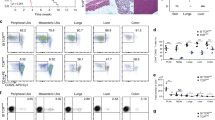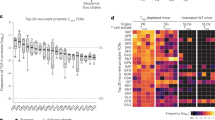Abstract
As T cells develop in the thymus, they become tolerant of self-antigens. A major advance in the understanding of how this process occurs was the direct demonstration that cells bearing autoreactive T-cell receptors (TCRs) are physically eliminated from the population of functionally mature T cells present in both the thymus and periphery1–3. We have sought to determine the developmental stage at which autoreactive T cells are eliminated by examining the expression of Vβl7a anti-I-E TCRs under various experimental conditions. In vivo antibody blockage of the CD4 molecule on developing thymocytes of I–E+ C57BR mice was found to inhibit the deletion of Vβ17a-bearing cells from the CD4–8+ single positive thymocyte subset. This result provides strong evidence that deletion of potentially autoreactive T cells occurs at a CD4+8+ precursor stage, that the non-clonally distributed accessory molecules (CD4, CD8) are significant participants in the self-recognition process that leads to clonal elimination, and that thymic class II major histocompatibility complex (MHC) molecules can influence the repertoire of CD4–8+ cells.
This is a preview of subscription content, access via your institution
Access options
Subscribe to this journal
Receive 51 print issues and online access
$199.00 per year
only $3.90 per issue
Buy this article
- Purchase on Springer Link
- Instant access to full article PDF
Prices may be subject to local taxes which are calculated during checkout
Similar content being viewed by others
References
Kappler, J. W., Roehm, N. & Marrack, P. Cell 49, 273–280 (1987).
Kappler, J. W., Staerz, U., White, J. & Marrack, P. C. Nature 322, 35–40 (1988).
MacDonald, H. R. et al. Nature 332, 40–45 (1988).
Ceredig, R., Glasebrook, A. L. & MacDonald, H. R. J. exp. Med. 155, 358–379 (1982).
Chen, W.-F., Scollay, R. & Shortman, K. J. Immun. 129, 18–24 (1982).
Harvan, W. L. et al. Nature 330, 170–173 (1987).
Finkel, T. H., McDuffie, M. A., Kappler, J. W., Marrack, P. & Cambier, J. C. Nature 330, 179–181 (1987).
Shortman, K. & Jackson, H. Cell. Immun. 12, 230–246 (1974).
von Boehmer, H. Immun. Today 7, 333–336 (1986).
Marrack, P. & Kappler, J. Science 238, 1073–1079 (1987).
Sharrow, S. O., Singer, A., Hammerling, U. & Mathieson, B. J. Transplantation (Baltimore) 35, 355–362.
Fowlkes, B. J., Edison, L., Mathieson, B. J. & Chused, T. M. J. exp. Med. 162, 802–822 (1985).
Dialynas, D. P. et al. J. Immun. 131, 2445–2451 (1983).
Bruce, J., Symington, F. W., McKearn, T. J. & Sprent, J. J. Immun. 127, 2496–2501 (1981).
Crispe, I. N. & Bevan, M. J. J. Immun. 138, 2013–2018 (1987).
Bluestone, J. A., Pardoll, D., Sharrow, S. O. & Fowlkes, B. J. Nature 326, 82–84 (1987).
Paterson, D. J. & Williams, A. F. J. exp. Med. 166, 1603–1612 (1987).
Smith, L. Nature 326, 798–800 (1987).
Irlé, C., Piquet, P.-F. & Vassalli, P. J. exp. Med. 148, 32–45 (1978).
Hardt, C., Pfizenmaier, K., Rollinghoff, M., Klein, J. & Wagner, H. J. exp. Med. 152, 1413–1418 (1980).
Blue, M.-L., Daley, J. F., Levine, H. & Schlossman, S. F. Proc. natn. Acad. Sci. U.S.A. 82, 8178–8182 (1985).
Kruisbeek, A. M. Thymus 1, 163–185 (1979).
Shortman, K. & Scollay, R. in Recognition and Regulation in Cell-Mediated Immunity (eds Wiltson, J. D. & Marbrook, J.) 31–60 (Dekker, New York, 1985).
Bryant, B. J. Eur. J. Immun. 2, 38–45 (1972).
McPhee, D., Pyle, J. & Shortman, K. Thymus 1, 151–162 (1979).
Sprent, J., Lo, D., Gao, E.-K. & Ron, Y. Immunol. Rev. 101, 173–190 (1988).
Kronenberg, M., Siu, G., Hood, L. E. & Shastri, N. A. Rev. Immun. 4, 529–591 (1986).
Weissman, D., Parker, D. J., Rothstein, T. L. & Marshak-Rothstein, A. J. Immun. 135, 1001–1003 (1985).
Hammerling, G. J., Hammerling, U. & Flaherty, L. J. exp. Med. 150, 108–116 (1979).
Author information
Authors and Affiliations
Rights and permissions
About this article
Cite this article
Fowlkes, B., Schwartz, R. & Pardoll, D. Deletion of self-reactive thymocytes occurs at a CD4+8+ precursor stage. Nature 334, 620–623 (1988). https://doi.org/10.1038/334620a0
Received:
Accepted:
Issue Date:
DOI: https://doi.org/10.1038/334620a0
This article is cited by
-
IL-23 promotes TCR-mediated negative selection of thymocytes through the upregulation of IL-23 receptor and RORγt
Nature Communications (2014)
-
The impact of circulating dendritic cells on the development and differentiation of thymocytes
Immunology & Cell Biology (2009)
-
The self and the nonself: Immunorecognition and immunologic functions
Immunologic Research (1993)
-
Co-engagement of CD8 with the T cell receptor is required for negative selection
Nature (1991)
-
Clonal deletion of immature CD4+8+ thymocytes in suspension culture by extrathymic antigen-presenting cells
Nature (1991)
Comments
By submitting a comment you agree to abide by our Terms and Community Guidelines. If you find something abusive or that does not comply with our terms or guidelines please flag it as inappropriate.



